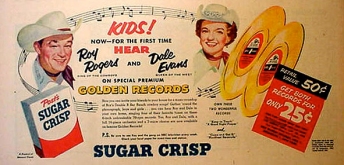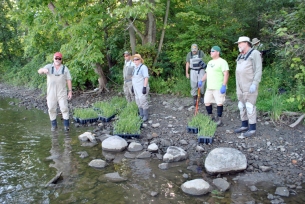I miss cereal.
Oh, I’m not totally cereal-bereft. I can—and do—still eat oatmeal, both because it’s good for my increasingly old body with its malfunctioning parts, and because it’s good.
No, the cereal I’m talking about is the boxed kind, the Honey Smacks and the Golden Crisp, and the Frosted Flakes.
Because part of the aforementioned malfunctioning of various parts is that for some reason this old body decided milk will now throw the plumbing system into serious, China Syndrome meltdown. So, goodbye bowl of cereal before bed. So long bowl of cereal for breakfast. Bye-bye bowl of cereal for mid-afternoon snack.
And it’s hard, because I enjoyed a lifelong love affair with the stuff.

I was lured to shredded wheat thanks to Straight Arrow’s tips on wilderness survival.
One of my earliest cereal memories is eating Nabisco shredded wheat, and looking forward to uncovering the pieces of cardboard that divided the three layers of shredded wheat biscuits in those rectangular boxes. That’s because there was neat stuff to read on those dividers.
Starting in 1949, the National Biscuit Company began printing “Straight Arrow’s secrets of Indian lore and know-how” on the dividers, which imparted all sorts of useful information, some of which still sticks in my mind to this day. The idea was that the innovative and inventive Indian, Straight Arrow, would explain how to survive in the wilderness as a way to get kids interested in eating shredded wheat. Because, let’s fact it. Shredded wheat is not a very interesting cereal, although it’s pretty healthy.

Straight Arrow could survive in the wilderness with practically no modern help at all. For a 6 year-old, it was an eye-opening introduction to living off the land.
So Nabisco not only sponsored the “Straight Arrow” radio program, starting in 1949, but they also contracted with Fred L. Meagher to created the illustrated cards. I don’t know about other little kids, but they certainly hooked me.
For instance, birch bark canoes were not white like the outside of the bark but were brown like the inner layer of the bark when it was peeled off birch trees. Why? Because when birch bark dries, it naturally curls with the white outer bark inside the curl. The brilliant Ojibwa marine architects who invented birch bark canoes took advantage of the natural curl of the sheets of bark they peeled off paper birch trees to fit the bark onto the canoes’ cedar frames.
Another card insisted that when finding himself in the wilderness, a person could survive if all he had was an ax, because with a good ax and the necessary survival skills you can manufacture about anything, from one of those birch bark canoes noted above to the paddles for the canoe to a cozy bark lodge for shelter from the storm.
But shredded wheat was far from the only cereal that got my gastronomical juices flowing, although as a rule, gastronomy took a backseat to cereals sponsored by my favorite TV shows.

Sugar Jets were hawked by one of my TV heroes, Jet Jackson, but each one of the things was like a little bomb dropped in my digestive tract.
Captain Midnight, for instance, was one of my favorites. It was sponsored by Ovaltine, which for some reason my mother absolutely refused to buy. But then in 1958, Captain Midnight’s name suddenly changed to Jet Jackson, and the Ovaltine sponsorship disappeared in favor of Sugar Jets Cereal. So I absolutely had to have a box of Jets in order to get the box top, but, it turned out, Jets did not agree with my digestive system at all.
So it was back to Kellogg’s Sugar Corn Pops (“Sugar Pops are tops!), Post Sugar Crisp and their Kellogg’s cousin, Sugar Smacks, and Kellogg’s Sugar Frosted Flakes (“They’re grrrrreat!”). Sugar Corn Pops were a big favorite because they were the main sponsor of “The Adventures of Wild Bill Hickok,” one my favorite TV westerns. Favorite because Wild Bill wore his twin six-shooters butt first, which was his gimmick. The Lone Ranger had his mask, silver bullets, and black two-gun rig; Hopalong Cassidy dressed in all black that showed off nicely against his white horse, Topper; and Red Ryder had his lever-action carbine, of which I got the Daisy BB gun version when I was 9 years-old. But Wild Bill and his sidekick, Jingle Jones (who was from East Sedalia) was arguably my favorite, and thus the reason I ate so many boxes of Sugar Corn Pops.

First Captain Video and then Roy and Dale beckoned me with the sirens’ call to Sugar Crisp cereal.
Post Sugar Crisp was a sponsor yet another favorite cowboy TV show, “The Roy Rogers Show,” which was a sort of surrealistic time-warped show. Almost everyone rode horses, including Roy (Trigger) and Dale Evans (Buttermilk), except Roy’s sidekick Pat Brady, who drove a 1946 Jeep that had been accessorized with armor plating and which he named Nellybelle.
Cowboys weren’t the only kids’ TV personalities hawking cereal, either. I was introduced to science fiction, a lifelong love, by watching “Captain Video and his Video Rangers,” which also got me sort of hooked on Post Sugar Crisp, thanks to Post’s sponsorship of the show even before Roy and Dale and Pat showed up on TV. It was my first introduction to a robot, the show’s TOBOR character (“robot” spelled backwards) and it frankly scared the beejebus out of me.
But all that was then, and this is now. Sugar Crisp, Sugar Corn Pops, Sugar Frosted Flakes, and the rest of those carbohydrate-packed cereals are actually still around, although in deference to today’s healthy eating aspirations, Sugar Crisps are now Honey Crisps, Sugar Corn Pops are just Corn Pops, and Sugar Frosted Flakes are merely Frosted Flakes.
I sometimes visit the cereal isle at the grocery store, when I can ditch my wife, who hates shopping with the heat of a thousand suns, so that for at least a few minutes I can relive the old days when digestion and metabolism were kinder processes in my much younger body. And at least I can sort of make do with my daily morning bowl of oatmeal, on which I’ve found my sugarless creamer makes a passable substitute for the milk I so enjoyed on all those cereals of decades past.
But I still miss cereal.






